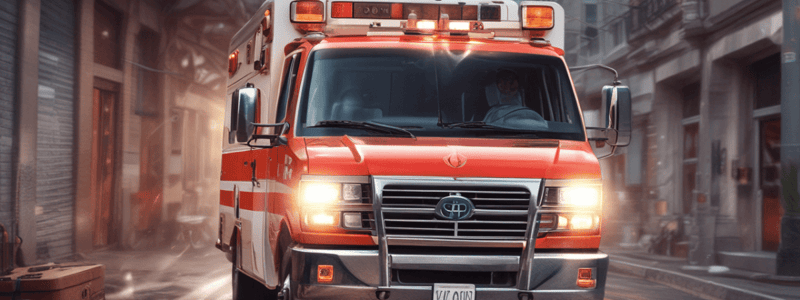Podcast
Questions and Answers
What is the criteria for determining which hospital to transport a patient to?
What is the criteria for determining which hospital to transport a patient to?
- Child's height and velocity of the crash (correct)
- Distance from the hospital
- Availability of a specialist
- Severity of the injury
What is a complication of crush injuries?
What is a complication of crush injuries?
- Electrolyte imbalance
- Hypervolemia
- Respiratory failure
- Rhabdomyolysis (correct)
What is a sign of compensated shock?
What is a sign of compensated shock?
- Weak, rapid pulse (correct)
- Labored breathing
- Altered mental status
- Hypotension
What is supine hypotensive syndrome?
What is supine hypotensive syndrome?
What is the management of supine hypotensive syndrome?
What is the management of supine hypotensive syndrome?
What is the cause of cardiogenic shock?
What is the cause of cardiogenic shock?
What is the treatment for anaphylactic shock?
What is the treatment for anaphylactic shock?
What is a sign of decompensated shock?
What is a sign of decompensated shock?
What is a complication of spinal cord injuries?
What is a complication of spinal cord injuries?
What is the 6 P's?
What is the 6 P's?
What is the primary concern in treating an abdominal evisceration?
What is the primary concern in treating an abdominal evisceration?
What is the indication for fluid resuscitation in hemorrhagic shock?
What is the indication for fluid resuscitation in hemorrhagic shock?
What is a sign of cardiac tamponade?
What is a sign of cardiac tamponade?
What is the treatment for a tension pneumothorax?
What is the treatment for a tension pneumothorax?
What is the primary goal of management in a traumatic brain injury?
What is the primary goal of management in a traumatic brain injury?
What is the sign of a retinal detachment?
What is the sign of a retinal detachment?
What is the treatment for a lacerated spleen?
What is the treatment for a lacerated spleen?
What is the indication for a cricothyrotomy?
What is the indication for a cricothyrotomy?
What is the primary concern in treating a patient with a spinal cord injury?
What is the primary concern in treating a patient with a spinal cord injury?
What is the treatment for a severe head injury?
What is the treatment for a severe head injury?
Flashcards are hidden until you start studying
Study Notes
Abdominal/GU Trauma
- Anatomy and Physiology of the Abdomen
- GLASSS-P ( RUQ, RLQ, LLQ, LUQ)
- Diaphragm (thoracic cavity, 4th and 5th intercostal space, 12th rib)
- Peritoneal cavity (upper and lower areas, contents)
- Retroperitoneal cavity (area posterior to peritoneal lining, contents)
- Pelvis (iliac vessels, organs, and structures)
- Solid and hollow organs (liver, spleen, pancreas, kidneys, etc.)
- Signs and Symptoms of a GI Bleed
- Hematuria (dark brown or bright red)
- Upper GI bleed (coffee ground emesis)
- Lower GI bleed (bright red blood)
- Distention, tenderness, and Cullen sign (ecchymosis around the umbilicus)
- Grey-Turner sign (ecchymosis of the flank)
- Signs and Symptoms of a Ruptured Diaphragm
- Abdominal pain, acute respiratory distress
- Decreased breath sounds, abdominal sounds in the chest
- Subcutaneous emphysema, sunken abdomen, associated injuries
- Right-sided diaphragmatic tear (liver injury)
- Left-sided diaphragmatic tear (spleen injury)
Bleeding
- Anatomy and Physiology of Hemorrhagic Shock
- Internal and external bleeding
- Blunt or penetrating injuries to vessels or organs
- Long bone or pelvic fractures
- Multisystem injury
- Indication for Fluid Resuscitation
- Internal hemorrhage ( fluid bolus of 250 ml of normal saline or lactated ringers)
- Hemorrhagic shock (fluid bolus of 250 ml, titrate to systolic BP of 80-90 mmHg)
- Signs and Symptoms of Hemorrhagic Shock
- Initial stage (low circulating blood volume with minimal signs of hypoperfusion)
- Compensated shock (agitation, anxiety, restlessness, etc.)
- Decompensated shock (altered mental status, hypotension, etc.)
Chest Trauma
- Identification of Beck's Triad
- Cardiac tamponade (excessive fluid in the pericardial sac)
- Beck's Triad (muffled heart tones, hypotension, JVD)
- Signs and Symptoms of a Cardiac Contusion
- Local tissue contusion and hemorrhage
- Edema, sharp retrosternal chest pain
- EKG changes (sinus tachycardia, A-Fib, etc.)
- Signs and Symptoms of a Pneumothorax
- Small pneumothorax (mild dyspnea, pleuritic chest pain)
- Large pneumothorax (increasing dyspnea, respiratory compromise, hypoxia)
- Open pneumothorax (defect in the chest wall, sucking chest wound)
Cranial Trauma
- Pathophysiology of a Traumatic Brain Injury
- Primary brain injury (injury to the brain and its associated structures)
- Secondary brain injury (consequence of primary injury, abnormal processes)
- Signs and Symptoms of a Traumatic Brain Injury
- Pupillary abnormalities (anisocoria, sluggish or nonreactive pupils)
- Period of unconsciousness, confusion, or disorientation
- Repeatedly asking the same questions (perseveration)
- Amnesia, combativeness, or other abnormal behavior
- Numbness or tingling in the extremities
- Loss of sensation and/or motor function
- Focal neurologic deficits
- Seizures
- Cushing triad (hypertension, bradycardia, irregular or erratic respirations)
Facial, Neck, and Spinal Trauma
- Anatomy and Physiology of the Head
- 28 bones make up the cranium and face
- Base of the skull (ethmoid, sphenoid, occipital, frontal, temporal)
- Brain (cerebrum, cerebellum, brainstem, meninges)
- Signs and Symptoms of Spinal Cord Injuries
- Paresthesia, paralysis, temp-sensation numbness
- Spinal shock (flaccid paralysis, flaccid sphincters, absent reflexes)
- Neurogenic shock (hypotensive, bradycardiac, skin warm, flushed, and dry)
- Neurons deficits (paralysis of small bowel, paralytic ileus)
Multisystem Trauma
- Calculating Mechanism of Injury
- Use trauma triage guidelines
- Falls, ejection from a vehicle, etc.
- Complications of a Crush Injury
- Rhabdomyolysis (muscle tissue becomes ischemic and dies)
- Electrolyte imbalances and acidosis
- Renal dysfunction leading to electrolyte abnormalities
- Renal failure
- Complications of Hypovolemia
- Electrolyte imbalances
- Compensated shock (agitation, anxiety, restlessness, etc.)
- Decompensated shock (altered mental status, hypotension, etc.)
Studying That Suits You
Use AI to generate personalized quizzes and flashcards to suit your learning preferences.




